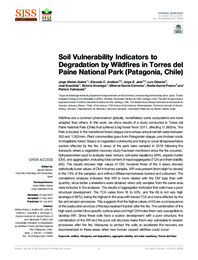Título :
Soil Vulnerability Indicators to
Degradation by Wildfires in Torres del
Paine National Park (Patagonia, Chile) |
Autor :
Mataix-Solera, Jorge
Arellano, Eduardo C.
Jaña, Jorge E.
Olivares, Luis
Guardiola, José
Arcenegui, Victoria
García-Carmona, Minerva
García-Franco, Noelia
Valenzuela, Patricio |
Editor :
Frontiers |
Departamento:
Departamentos de la UMH::Agroquímica y Medio Ambiente |
Fecha de publicación:
2025 |
URI :
https://hdl.handle.net/11000/36240 |
Resumen :
Wildfires are a common phenomenon globally, nonetheless some ecosystems are more
adapted than others. In this work, we show results of a study conducted in Torres del
Paine National Park (Chile) that suffered a big forest fire in 2011, affecting 17,666 ha. The
Park is located in the transitional forest-steppe zone whose annual rainfall varies between
300 and 1,500 mm. Plant communities goes from Patagonian steppe, pre-Andean scrub
to Magellanic forest. Based on vegetation community and trying to cover all representative
sectors affected by the fire, 5 areas of the park were sampled in 2019 following the
transects where a vegetation recovery study has been monitored since the fire occurred.
Soil parameters used to evaluate were: texture, soil water repellency (WR), organic matter
(OM), and aggregation, including total content of macroaggregates (TCA) and their stability
(AS). The results showed high values of OM, however three of the 5 areas showed
statistically lower values of OM in burned samples. WR was present (from slight to severe)
in the 75% of the samples, and without differences between burned and unburned. The
correlations analyses indicated that WR is more related with the OM type than with
quantity, since better correlations were obtained when only samples from the same area
were included in the analyses. The results of aggregation indicated that soils have a poor
structural development. The TCA varies from 16 to 50%, and the AS is not very high
(average of 66%), being the highest in the area with lowest TCA and more affected by the
fire and erosion processes. This suggests that the higher values of AS are a consequence
of the destruction and loss of the less resistant fraction after the fire. The combination of the
high sand content (low specific surface area) and high OM make them very susceptible to
develop WR. Since these soils have a scarce development with a poor structure, the
combination of the WR and the poor soil structure make them very vulnerable to erosion
processes after the fire. Measures to protect the soils or accelerate the recovery are
recommended in these areas when new human caused wildfires could occur.
|
Palabras clave/Materias:
wildfire
Patagonia
soil degradation
aggregate stability
soil water repellency
Torres del Paine |
Área de conocimiento :
CDU: Ciencias puras y naturales: Química |
Tipo de documento :
info:eu-repo/semantics/article |
Derechos de acceso:
info:eu-repo/semantics/openAccess
Attribution-NonCommercial-NoDerivatives 4.0 Internacional |
DOI :
https://doi.org/10.3389/sjss.2021.10008 |
Publicado en:
Spanish Journal of Soil Science July 2021 | Volume 11 | Article 10008 |
Aparece en las colecciones:
Artículos Agroquímica y Medio Ambiente
|
 La licencia se describe como: Atribución-NonComercial-NoDerivada 4.0 Internacional.
La licencia se describe como: Atribución-NonComercial-NoDerivada 4.0 Internacional.
.png)
